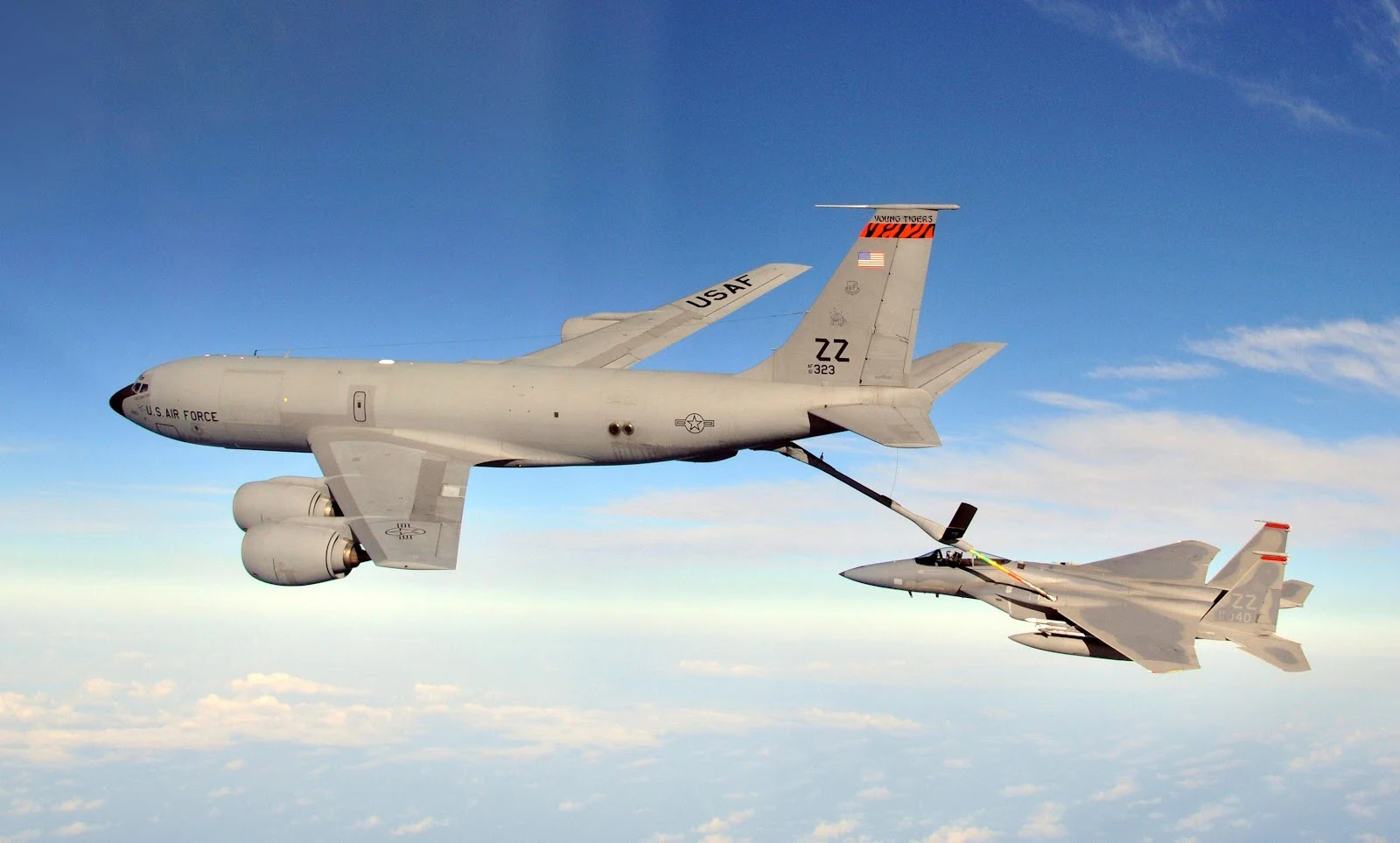KC-135 Stratotanker: The Backbone of U.S. Aerial Refueling Since 1956

The KC-135 Stratotanker stands as one of the most significant military aircraft in U.S. Air Force (USAF) history. Originally developed by Boeing in 1952 as a private venture, the aircraft was designed with a clear purpose—to support America’s long-range strategic bombers with an inflight refueling capability. This vision became a reality when the USAF officially selected the aircraft in 1954, and the KC-135 made its maiden flight just two years later, in 1956.
By 1957, the USAF formally adopted the KC-135 as its primary aerial refueling platform. It became the most widely produced variant of the C-135 Stratolifter family, with 732 units delivered before production ended in 1965. Even decades later, the KC-135 remains a critical component of the U.S. tanker fleet. As of 2016, around 400 KC-135s are still in operation—comprising approximately 160 active-duty aircraft, 60 from the Air Force Reserve, and another 180 under the Air National Guard.
Today’s operational versions include the KC-135R and KC-135T, which work alongside the larger KC-10 Extender. However, the long-term plan involves gradually replacing the Stratotanker with the next-generation KC-46 Pegasus. Even so, technical assessments suggest that many KC-135s could remain flightworthy and operational until at least 2040.
| KC-135 Stratotanker Specifications | |
|---|---|
| Country of origin | United States |
| Entered service | 1957 |
| Crew | 3 - 4 men |
| Dimensions and Weight | |
| Length | 41.53 m |
| Wing span | 40 m |
| Height | 12.7 m |
| Weight (empty) | 45 t |
| Weight (maximum take off) | 146 t |
| Engines and Performance | |
| Engines | 4 x Pratt & Whitney J57 turbojets |
| Engines (KC-135R) | 4 x CFM International CFM56 turbofans |
| Traction (KC-135R) | 4 x 96.2 kN |
| Maximum speed (KC-135R) | 933 km/h |
| Cruising speed (KC-135R) | 853 km/h |
| Service ceiling (KC-135R) | 15.2 km |
| Range with 68 t of fuel (KC-135R) | 2,400 km |
| Ferry range (KC-135R) | 17,766 km |
| Fuel and Cargo | |
| Fuel load | Up to 90,700 kg |
| Passengers | Up to 80 men |
| Maximum payload | Up to 37,600 kg |
Global Operators Beyond the USA
While primarily operated by the United States, a few allied nations also use the KC-135 for their air force refueling needs. Countries such as France, Chile, Singapore, and Turkey maintain small fleets of KC-135 aircraft, underscoring the platform’s enduring global value.
KC-135: Design, Capabilities, and Performance
Smaller than Boeing’s commercial Model 707, the KC-135 was the USAF’s first jet-powered aerial refueling tanker. Initially intended to support strategic bombers, its mission expanded significantly during the Vietnam War to include the refueling of fighter jets and tactical bombers. This shift allowed frontline combat aircraft to maintain extended operational time over conflict zones—a critical tactical advantage.
Some older USAF C-135 aircraft were later converted to the KC-135 tanker configuration, further extending the versatility and lifespan of the platform.
Fuel and Refueling Systems
The KC-135 can carry up to 90,700 kilograms of fuel. It primarily uses Boeing’s patented “flying boom” inflight refueling system for efficient fuel transfer. For added flexibility, some aircraft are also equipped with underwing refueling pods, allowing compatibility with a wider variety of receiver aircraft.
Crew and Cargo
The Stratotanker operates with a three-person crew: a pilot, co-pilot, and boom operator. On certain missions, a navigator may also be onboard. In addition to its primary role as a tanker, the KC-135 has secondary transport capabilities. The upper cargo deck can be configured to carry up to 80 passengers or up to 37,600 kilograms of cargo, depending on fuel load and mission profile.
Powerplant Evolution
Originally, the KC-135 was equipped with Pratt & Whitney J57 turbojet engines. Over the years, these were replaced with more powerful and fuel-efficient turbofans, enhancing performance and reducing operational costs—particularly in later variants such as the KC-135R and KC-135T.
Variants of the KC-135 Stratotanker
- KC-135A: The original production version powered by Pratt & Whitney J57 engines. A total of 732 were built.
- KC-135B / EC-135C: Initially configured as an airborne command post. Seventeen units were built, later modified with refueling capability.
- KC-135D: Converted from RC-135A reconnaissance aircraft to tankers. Only four units were converted, all retired by 2007.
- KC-135E: Upgraded from KC-135A with TF33 turbofans. 161 units were converted; all retired by 2009.
- KC-135Q: Originally designed to carry JP-7 fuel for the SR-71 Blackbird and F-117 Nighthawk. Fifty-six aircraft were modified to this standard, with 54 later upgraded to KC-135T.
- KC-135R: The most advanced and numerous variant, equipped with CFM-56 (F108-CF-100) turbofans. Over 361 conversions were made from earlier models.
- KC-135T: Modified from KC-135Q aircraft, also fitted with CFM-56 engines. Total of 54 aircraft converted.
- C-135FR: The French Air Force version, similar in function to the KC-135. These aircraft feature a compatible refueling system and are still in service.
Future of the KC-135: Still Flying Strong in the 21st Century
Despite being introduced over six decades ago, the KC-135 Stratotanker continues to serve as a cornerstone of U.S. aerial refueling operations. Its reliability, upgrade potential, and adaptability have made it one of the most successful and enduring aircraft in military aviation history.
As the USAF integrates newer platforms like the KC-46 Pegasus, the KC-135 is expected to gradually phase out. However, with ongoing upgrades and structural evaluations confirming their longevity, many of these aircraft could remain operational until 2040 or beyond.

Posting Komentar